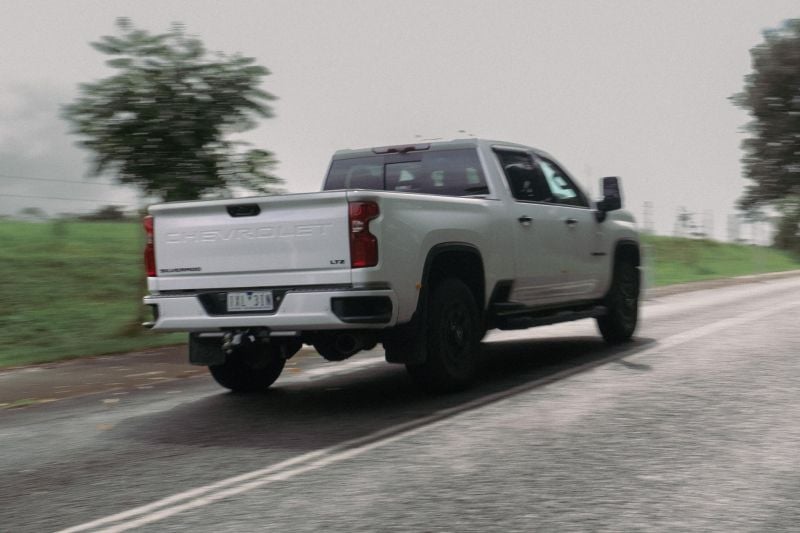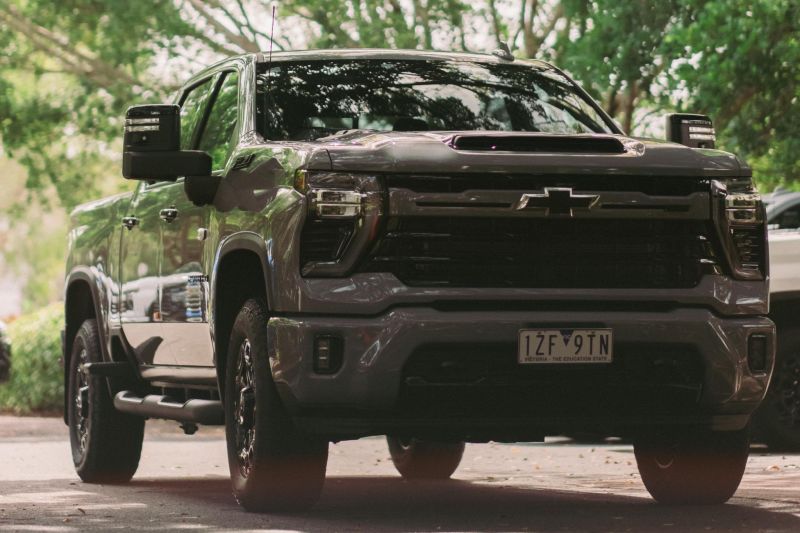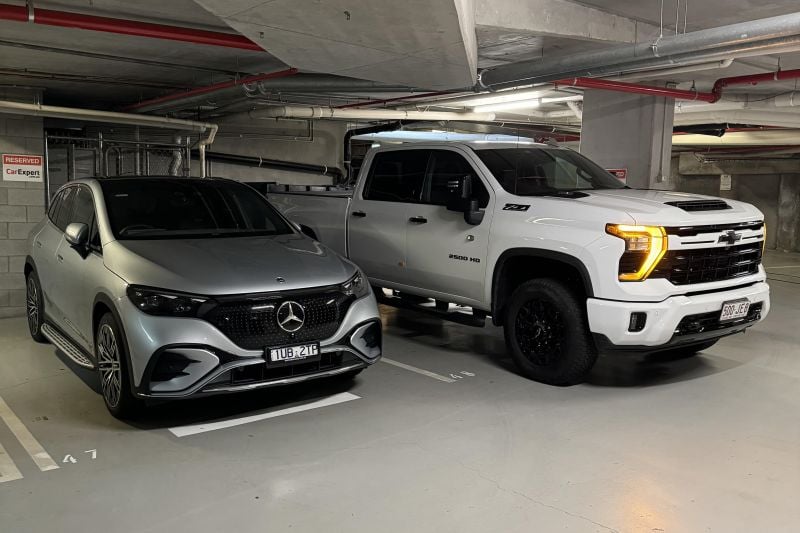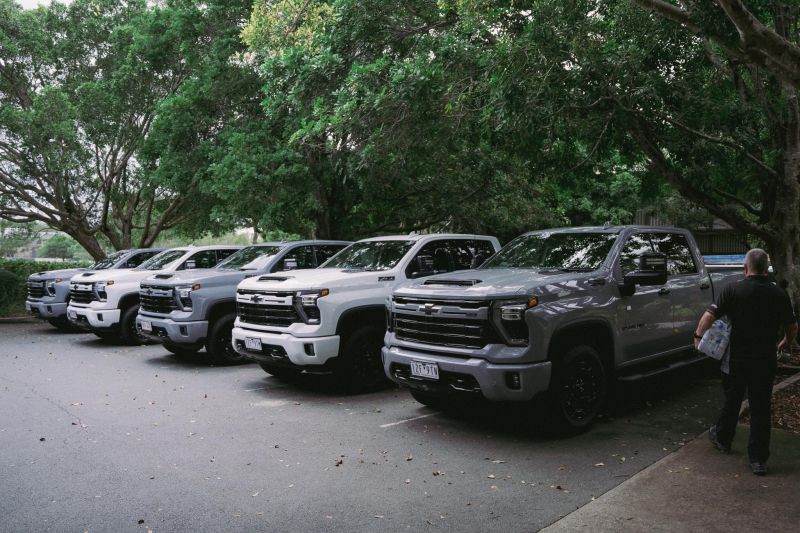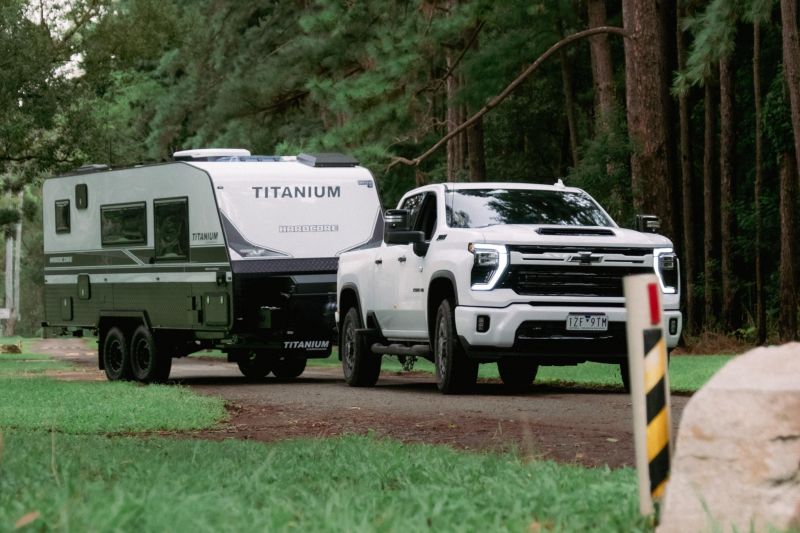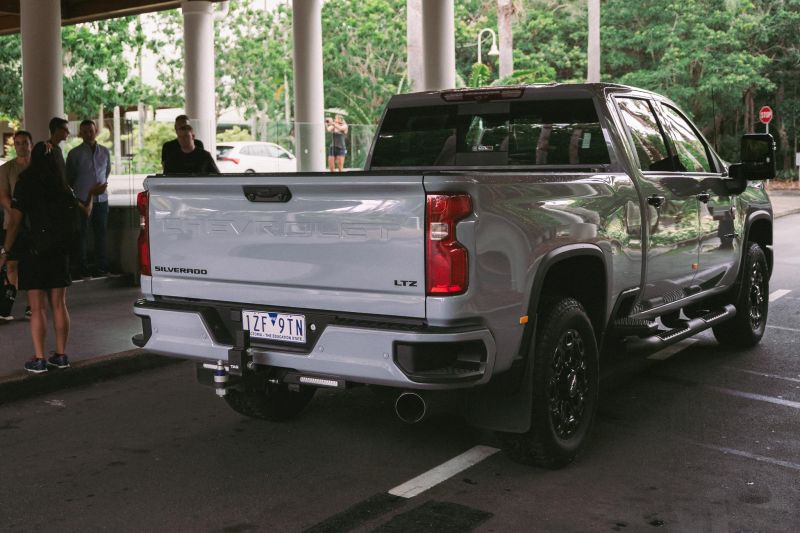The Chevrolet Silverado 2500 HD is currently the biggest pickup truck offered by General Motors Speciality Vehicles (GMSV) in Australia. This isn’t your grandpa’s ute.
This almost 6.4-metre long and 3.7-tonne American heavy-duty pickup is aimed at those who load it up with equipment and tow a heavy trailer on the regular. But people are going to drive them in town as well… so I decided to do just that and see what it was like.
Sales of big American pickups, most of which cost more than $100,000 on the road, are booming. People are already fired up about them, the amount of space they require, and their impact on pedestrians – but the majority are a size smaller than the Silverado 2500 HD, which is 450mm longer and 1.2 tonnes heavier than the Silverado 1500.
I’ve spent a bit of time behind the wheel of some heavy machinery – as in, proper farm machinery that makes the Silverado 2500 HD look like a toy.
I grew up on a primary producer farm between Melbourne and Adelaide, and have been driving (on private property) since before I could properly see over the wheel. I’ve had years of operating machinery on the farm, including tractors, harvesters, telehandlers, and trucks.
With a Heavy Rigid licence, I’m actually overqualified (please leave praise in the comments) to drive the proper NB2 Silverado 2500 HD, rather than the watered-down NB1 version (less payload, lower GVM) for mere mortals with their car licences. (Jack is joking here… I think – Ed.)
Driving into Brisbane and cruising around Fortitude Valley in peak hour traffic in the Silverado 2500 HD was initially a little nerve-wracking. At almost 2.3 metres wide it fills a lane, but after a while you get used to being a little closer to the white lines than in a Ford Ranger or Toyota HiLux.
Before you say this is too large for Australian lanes, the current national standard stipulates a minimum traffic lane width of 3.5 metres. A minimum traffic lane width of 3.3 metres is allowed in certain scenarios.
The standard road lane width in the US however is between nine and 12 feet, which roughly converts to between 2.7 metres and 3.6 metres. Sounds pretty comparable to me.
Sitting so high in such a monstrous vehicle attracted plenty of eyeballs from pedestrians and other road users. This was a nice novelty and actually came in handy when changing lanes in bumper-to-bumper Brisbane peak-hour traffic as other cars would give way.
I’m not certain if they were being nice or they were terrified. Regardless I was thankful they let me change lanes willy-nilly because I was unfamiliar with the confusing, meandering one-way roads in Brisbane.
The interesting part about driving the Silverado 2500 HD came when I was looking for a park. At almost 6.4-metres long, it well and truly hangs over the lines.
Australian standards call for parking spaces to measure 5.4m long and 2.4m wide. These standards came about when Aussies were buying smaller cars; most of the current top-selling vehicles, including the Ford Ranger and Toyota HiLux, are pushing the bounds in 2024.
Things got even more interesting as I needed to head into a multi-storey carpark. The Silverado 2500 HD is just over 2.0m tall which means you’ll need to double check you’re not going to scratch the roof – although anyone who’s driven a large van will also be familiar with this.
Thankfully I didn’t need to worry too much about that where I was going.
The pickup also has a huge turning circle, which means you’ll be forced to become acquainted with doing a three- (or perhaps 10-) point turns. This all comes with time, and being very patient.
It’s nice to have a crisp and clear surround-view camera in the Silverado 2500 HD, as well as front and rear parking sensors. They definitely were put to use when I wedged the pickup into a tight parking spot in a multi-storey carpark, but they make what should be a scary task simpler than you’d expect.
Parking this kind of heavy vehicle is incredibly topical right now as Yarra Council in Melbourne recently voted to look into imposing higher parking fees on American-style utes and SUVs.
Our own Paul Maric loved his time in the Ford F-150 over the Christmas break; I’m not sure he would’ve been as enamoured of life in the confines of the city in the bigger Silverado 2500.
You can definitely drive it around town more easily than you’d expect, but it’s a lot of effort. It’s tiring. Trying to squeeze into city lanes and finding a suitable car park for this hulking pickup isn’t for the faint-hearted.
The Silverado 2500 HD’s capabilities in the city also felt wasted. Sure the 6.6-litre V8 turbo-diesel is very powerful and torquey, there’s oodles of interior storage, and the tub is palatial, but it’s ultimately useless when you’re driving just yourself with no kit.
I felt like the biggest gas-guzzling hillbilly behind the wheel by myself, but I suppose that’s technically correct given I grew up on a farm and should really embrace my roots. I love that for me.
After spending a day using the Silverado 2500 HD in its natural environment (open roads, dirt tracks, towing a caravan), it’s clear what it does well.
With that said, the overall experience in town was a tad daunting at first… but then became second nature in tighter spaces.
I’m definitely not advocating everyone should really be driving this kind of vehicle in urban environments, but I think you’d be surprised the amount of places you can actually squeeze in.
It’s a tool for a specific job, and you’d have to be a bit of a tool yourself to try and use it full-time in the city – that’s what Chevrolet will tell you the Silverado 1500 is for (I’ll have a Corvette thanks – Ed.). You sacrifice some towing capacity, but it’s a much easier thing to pilot in tight spaces.
But even the king of Chevrolet pickups in Australia can be driven in the city without the sky falling in, the birds falling out of the trees, and multi-storey carparks collapsing.
Bring on the Silverado 3500 HD.
MORE: Everything Chevrolet Silverado HD
MORE: Chevrolet Silverado 2500 HD review

